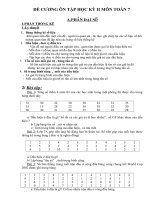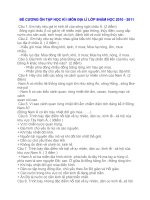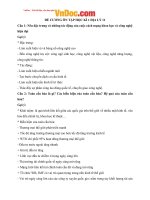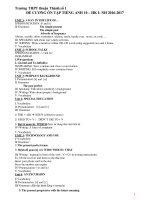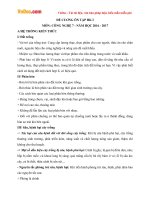Đề cương ôn tập học kì 2 môn tiếng anh lớp 11 phần 2 | Tiếng Anh, Lớp 11 - Ôn Luyện
Bạn đang xem bản rút gọn của tài liệu. Xem và tải ngay bản đầy đủ của tài liệu tại đây (157.99 KB, 7 trang )
<span class='text_page_counter'>(1)</span><div class='page_container' data-page=1>
<b>ĐỀ CƯƠNG ÔN TẬP MÔN TIẾNG ANH LỚP 11 - HỌC KÌ II</b>
<b>A. Ơn lại kiến thức học kì I.</b>
1. Infinitive with to and without to, gerund: to V, V,Ving.
2. Tenses: Thì
3. Conditional types 1, 2 and 3: Câu điều kiện
4. Reported speech: Câu gián tiếp (với câu trần thuật, hỏi, mệnh lệnh, điều kiện)
<b>4.1. Câu trần thuật: “S + V </b>
…
”
told + O
<b>S + + (that ) +S + V (lùi 1 thì)</b>
said + (to +O)
<b>4.2. Câu hỏi:</b>
<b>a/ WH_ Questions: “WH + auxilary + S + V ?”</b>
<b>b/ YES _ NO Questions: “Auxilary + S + V ?”</b>
asked
S + wanted to know + (O)
wondered
…..
<b>+ WH</b>
<b>S + V (lùi thì)</b>
<b>+ IF / WHETHER</b>
<i><b> 4.3. Câu mệnh lệnh : (Don't + V…) </b></i>
told
S + asked + O +
………
to V (Mệnh lệnh khẳng định)
not + to V (Mệnh lệnh phủ định)
<b>4.4. Dùng Ving, to V để đổi sang câu gián tiếp</b>
<b>B. Kiến thức học kì II.</b>
<b>I. Cách sử dụng đại từ quan hệ và trạng từ quan hệ </b>
1.
<b>Đại từ quan hệ: who, whom, whose, which, that</b>.<b> Who: được dùng để thay thế cho danh từ chỉ người và làm chủ ngữ hoặc tân ngữ cho động từ </b>
trong mệnh đề quan hệ (…… N + who + V hoặc N + who + S + V)
<b> Whom: được dùng thay thế cho một danh từ chỉ người và làm tân ngữ cho động từ trong mệnh </b>
đề quan hệ. (……N + whom + S + V)
<b>The man whom you met yesterday is my brother.</b>
<b> Whose: là đại từ quan hệ sở hữu, thay thế cho danh từ chỉ người hoặc danh từ chỉ vật (thay cho: </b>
his, her, its, their, Tom’s…)
<b>The house whose windows are broken is mine.</b>
<b> + Riêng danh từ chỉ vật có thể thay thế bằng the + N + of which</b>
Example: The house the window of which are broken is mine
<b> Which: được dùng làm chủ ngữ hoặc tân ngữ thay thế cho danh từ chỉ đồ vật, con vật hoặc sự </b>
<b>việc. Example: This is the book which I like best.</b>
<b> That: được dùng thay thế cho danh từ chỉ người hoặc chỉ vật, hoặc chủ ngữ gồm cả người và </b>
vật, sau những đại từ không xác định, hoặc sau dạng so sánh nhất…
<b>Example: - That is the bicycle that/ which belongs to Tom.</b>
<b>2. Trạng từ quan hệ: why, where, when.</b>
<b>Why: mở đầu cho một mệnh đề quan hệ để chỉ ngun nhân, lí do.(có thể thay thế bằng That)</b><b>I don’t know the reason why/ that you didn’t go to school yesterday.</b>
<b>Where (=on, in, at which) mở đầu cho một mệnh đề quan hệ chỉ địa điểm nơi chốn.</b><b>The hotel where we stayed wasn’t very clean.</b>
<b>When (=on/ in/ at which) mở đầu cho mệnh đề quan hệ chỉ thời gian. </b><b>I will never forget the day when I first met my husband</b>
<b>II. Vị trí của giới từ trong mệnh đề quan hệ</b>
Trong mệnh đề quan hệ, khi đại từ quan hệ làm tân ngữ cho giới từ thì thường được đặt ở 2 vị<b>trí: trước đại từ quan hệ WHOM, WHICH hoặc sau động từ.</b>
<b>Trong lối văn phong trang trọng, giới từ được đứng trước đaị từ quan hệ WHOM, WHICH</b><b>The man to whom my mother is talking is my form teacher.</b>
</div>
<span class='text_page_counter'>(2)</span><div class='page_container' data-page=2>
<b> chú ý: * không dùng giới từ với THAT hoặc WHO</b>
<b>III. Các loại mệnh đề quan hệ</b>
<b>1.</b> <b>Mệnh đề quan hệ xác định (Defining Relative Clause): là mệnh đề được dùng để xác định </b>
danh từ đứng trước nó. Mệnh đề quan hệ xác định là mệnh đề cần thiết cho ý nghĩa của câu, không
có nó câu sẽ khơng đủ nghĩa.
The man who robbed you has been arrested.
trong mệnh đề quan hệ xác định có thể bỏ các đại từ quan hệ làm tân ngữ.
The book you lent me was very interesting.
<b>2.</b> <b> Mệnh đề quan hệ không xác định (Non – defining relative clause): là mệnh đề cung cấp </b>
<b>thêm</b>
thông tin về một người, một vật hoặc một sự việc đã được xác định. Đây là mệnh đề không nhất
thiết phải có trong câu, khơng có nó câu vẫn đủ nghĩa. Mệnh đề quan hệ không xác định được
tách khỏi mệnh đề chính bởi dấu phẩy hoặc dấu gạch ngang.
That man, who lives in the next flat, looks very lonely.
<b>Không dùng đại từ quan hệ THAT trong mệnh đề quan hệ không xác định</b> Những danh từ đứng trước mệnh đề quan hệ thường là: Tên riêng, danh từ có tính từ sở hữu,
danh từ có tính từ chỉ thị: This, That, These, Those...
Không thể bỏ các đại từ quan hệ làm tân ngữ.
<b> Trong mệnh đề này WHICH có thể dùng để thay thế cho cả mệnh đề đứng trước nó</b>
Trong mệnh đề quan hệ không xác định, các cụm từ chỉ số lượng: all of/ most of/ neither of/
<b>many of… có thể được dùng với WHOM, WHICH và WHOSE</b>
Mary has three brothers, all of whom are married.
<b>IV. Dạng rút gọn của mệnh đề quan hệ: </b>
<b>1. Cụm phân từ</b>
a)
<b>Hiện tại phân từ (V_ing ): được dùng khi động từ trong mệnh đề quan hệ chia ở các thì hiện tại</b>đơn, hiện tại tiếp diễn, quá khứ đơn, quá khứ tiếp diễn, hoặc khi động từ trong mệnh đề quan hệ
diễn tả mong muốn, hi vọng, mong đợi…
That man, who is sitting next to Mary, is my uncle.
That man, sitting next to Mary, is my uncle
b)
<b>Quá khứ phân từ (Vpp = Ved</b><b>3): quá khứ phân từ đựơc dùng khi động từ trong mệnh đề quan hệ</b>
ở dạng bị động.
<b>The boy who was injured in the accident was taken to the hospital.</b>
<b>The boy injured in the accident was taken to the hospital.</b>
2.
<b>Động từ nguyên mẫu (To infinitive): được dùng sau số thứ tự The first, the second,…, hoặc </b>sau các từ: the last, the only, the next hoặc có động từ khuyết thiếu, hoặc sau so sánh nhất.
The captain was the last person who left the ship.
→ The captain was the last person to leave the ship.
Here is a form that you must fill in.
→ Here is a form for you to fill in.
<b>V. Cleft sentences: Câu nhấn mạnh </b>
<b>1. Câu nhấn mạnh chủ ngữ (subject focus): It is/ was + S + that/ who + V…: </b>
<b>The boy visited his uncle last month.</b>
<b>It was the boy that/ who visited his uncle last month</b>
<b>2. Câu nhấn mạnh tân ngữ (Object focus): It is/ was + O + That/ Who + S + V</b>
<b>3. Câu nhấn mạnh trạng từ (Adverbial focus): It is/ was + Adv + that + S + V </b>
<b>4. Câu nhấn mạnh bị động: It is/ was + O + that + is/ are/ was/ were + Vpp</b>
<b>People talked a lot about his house.</b>
It was his house that was talked a lot about
<b>VI. Tag question: câu hỏi đi</b>
<b>1. Quy tắc chung</b>
<b>- Câu nói và phần đi ln ở dạng đối nhau tức là:</b>
+ Nếu câu nói trước dấu phẩy là câu khẳng định, câu hỏi đuôi phải ở thể phủ định.
+ Nếu câu nói trước dấu phẩy là câu phủ định, câu hỏi đuôi phải ở thể khẳng định
<b>a. Câu khẳng định, trợ động từ-n’t + S?</b>
Ex: He works every day, doesn’t he?
<b>b. Câu phủ định, trợ động từ + S?</b>
</div>
<span class='text_page_counter'>(3)</span><div class='page_container' data-page=3>
a. Chủ từ của phần đuôi thường là đại từ nhân xưng : I, He, She, It, You, We, They.
b. Trường hợp đặc biệt:
<b>- this / that → it </b>
<b>- these / those → they</b>
<b>- There → there</b>
<b>- everything, anything, nothing, something → it</b>
<b>- everyone, everybody, someone, somebody, anyone, anybody, no one, nobody, none, neither → they</b>
<b>3. Một số trường hợp đặc biệt</b>
<b>- I am → aren't I</b>
<b>- Let's → shall we</b>
<b>- Câu mệnh lệnh: (Don't) + V +… → will you</b>
<b>VII. Liên từ cặp đôi: Conjunctions (Ơn qua)</b>
<b>Both …and: vừa…vừa, cả…và, Not only…but also: khơng những…mà còn, Either…or: hoặc cái </b>
<b>này/người này, hoặc cái kia/người kia, Neither… nor: không cái này/người này cũng không cái </b>
kia/người kia
Các cặp liên từ này có cấu trúc song hành tức là: từ, cụm từ trước và sau cặp liên từ này phải
cùng từ loại, chức năng ngữ pháp với nhau.
Eg: He both smokes and drinks.
<b>Both …and động từ ln chia ở dạng số nhiều, cịn các cặp còn lại: either…or, neither…nor, </b>not only…but also… động từ chia phù hợp với chủ ngữ thứ 2 (đứng gần động từ nhất).
Eg: Both you and I are students.
Either you or I am ưởng.
<b>VIII. Passive voice with THAT Clause: Câu bị động với mệnh đề "that" (Ôn qua)</b>
<b>S1 + V1 + that + S2 + V2 </b>
<b>→ </b>
<b>It + be + V1pp + that + S2 + V2 </b><b> </b>
<b>→ </b>
<b>S2 + be + V1pp + to V2</b>Chú ý: - Be chia theo thì của V1
- V1 thường là: agree, hope, believe, consider, feel, know, think, say, understand, find, expect…
<b>EXERCISES: BÀI TẬP</b>
<i><b>I. Put the verb in the correct tense.</b></i>
1. They (practice) their music lesson at 7 o'clock tomorrow.
2. I wouldn't have eaten it if I (know) that there was ginger in it.
3. Be quiet! The teacher (explain) the lesson.
4. Ice (turn) to water if you heat it.
5. If I (try) again I think that I would have succeeded.
6. There (be) many tall and big trees in front of my house in 1998.
7. They went home after they (finish) their work.
8. The bell rang while Tom (take) a bath.
9. I could get a job easily if I (have) a degree.
10. We (not see) her since we (be) on holiday in Ha Long bay.
11. Phuong (not finish) her homework yet.
12. When I was young, I ( want) to be a bus driver.
13. Last night when we (visit) him, he (do) an experiment on the upstairs.
14. As soon as I (have) enough money, I'll buy a new car.
</div>
<span class='text_page_counter'>(4)</span><div class='page_container' data-page=4>
<i><b>II. Put the verb in the correct form: Gerund, Infinitive with to and Infinitive without to. </b></i>
<i><b> 1. Whenever we met, Jack avoided (look) at me. </b></i>
2. I remembered (return) you the book. I gave it to you last week.
3. There is no point in (find) up a new opposition.
4. Don’t let the children (stay) up too late.
5. You had better (eat) properly.
6. I am looking forward to (become) an engineer.
7. It is too cold (do) anything.
8. It is no use (read) the newspaper.
9. Hanh isn’t old enough (drive).
10. She had better (sleep) early.
11. It is easy (guess) his attitude.
12. Most people enjoy (visit) to different parts of the world.
13. He made me (create) many new products.
14. She refused (go) out with me.
15. When I entered the room, I smelt something (burn).
<i><b>III. Rewrite the following sentences into the reported speech.</b></i>
1. “ If I catch the plane I’ll be home by five, ” he said.
→ He said ………
2. “ If I had had my mobile yesterday , I would have contacted you,” my mother said.
→ My mother said ………
3. “I will bring the sandwiches to the party” said Helen.
→ Helen offered ...
4. “I’m sorry I’m late”
→ He apologised ……….
5. “I shall return books tomorrow,” she said.
→ She said ……….
6. “Where did you go last night?” his father asked him.
→ His father asked ………
7. “Don’t make noise,” the teacher said to us.
→ The teacher told ……….
8. “ I hear you got the first prize. Congratulation!” she said to me.
→ She congratulated ……….
9. “ What would you do if you had three days off ?” I asked him.
→ I asked him ………
10 . “Do you know where Jean is living?” he asked me.
→ He asked me ……….
<b>IV.CHOOSE THE BEST OPTION TO COMPLETE THE SENTENCES</b>
1.He neither plays nor ……… football.
A. watch B. to watch C. watches D. watched
2. He has three children, all of ……… have graduated from university.
A. who B. whom C. whose D. that
3. The fans cheered when their team ……… a goal.
A. scored B. won C. gained D. got
4. I think you’ve seen this one before, ………?
A. do I B. don’t I C. have you D. haven’t you
5. He is said ……… 108 years old.
A. be B. to be C. will be D. being
6. He never had the ……… of seeing his paintings recognized and admired.
A. satisfy B. satisfying C. satisfaction D. satisfactory
7. Collecting dolls is her ……… hobby.
A. favourite B. preferred C. liked D. popular
8. How many countries ……… in the last Asian Games?
A. took part B. participated C. entered D. A or B
9. That’s the girl about ……… I’ve talked to you.
A. that B. who C. whom D. X (nothing)
</div>
<span class='text_page_counter'>(5)</span><div class='page_container' data-page=5>
A. couldn’t B. weren’t able to C. was impossible to D. was incapable of
11.Monica , ………is my new boss , is very easy to work with .
A. whose B. that C. who D. whom
12 The biggest reason for ……….I didn’t take the job is the low pay .
A. which B. why C. that D. when
13I don’t like people ………. arrive late .
A. who B.whom C. which D. both A & B
14I live in a house ……….. a century ago .
A. building B.built C. to built D.build
15The last person ……….. interviewed yesterday was Jack .
A. is B. being C. to be D.was
16 He hasn’t got anything ……….. .
A. wear B. wearing C. wore D. to wear
17 There are some reports ……… you have to type right now .
A. which B. that C. who D. both A & B
18 He was the first man ……….. me the truth.
A. tell B. telling C. to tell D. told
19 The meeting to ……… I went was interesting.
A. that B. which C. whom D. both A & B
20. I like diamond ring ……… Mary is wearing.
A. which B. that C. X (nothing) D. all are correct
21. The person ………. did it was never caught.
A. who B. whom C. X (nothing) D. all are correct
22. The hotel has special ……… for disabled athletes.
A. effort B. enthusiasm C. facilities D. events
23. Swimming and water skiing are both ……… sports.
A. aquatic B. advancing C. squash D. rugby
24. I had to drive to the factory to pick up my brother ……… car wouldn’t start.
A. who his B. who C. who’s D. whose
<b>V. Find and corect the mistake</b>
1.My close friend, (A) that (B) I’ve lost touch with (C)for 3 years, has (D) just returned from India .
2. (A)That’s (B) the young man to (C)that I (D) spoke.
3.Human beings (A) whom live (B) longer than one hundred years (C) are a (D)rarity.
4. The (A) last person (B) leaving the room(C) must turn off (D) the light.
5. It (A) was the man (B) which (C) gave her the (D) book.
6. (A) The man (B) spoke (C) to John (D) is my brother.
7. (A) Neither Lam (B) nor his brothers (C) don’t like horror (D) films.
8. (A) You’re going (B) to Helsinki (C) this weekend, (D) haven’t you?
9. The Great Wall of China (A) reported to have (B) been built (C) in the late of (D) 1400s.
10. (A) That sign (B) isn’t too small (C) to read, isn’t(D) it?
<b>VI. Choose the word whose underlined part is pronounced differently from that of the others</b>
<b>in each group </b>
1. A. hopes B. phones C. books D. visits
2. A. reserve B. conserve C. release D. research
3. A. machine . B. sugar C. sure D. expensive
4. A. polluted B.prevented C. needed D. advised
5. A. amount B. count C. without D. source
6. A.stops B. clubs C. maps D.books
7. A. robbed B. worked C. jumped D. stopped
<i>8. A. laughs</i> <i> B. loves </i> <i>C. travels D. robs</i>
<i>9. A. month</i> <i> B. seventh</i> <i>C. that</i> <i>D. think</i>
10. A. nature B. mutual C. picture D. residential
<b>VII. Rewrite each sentence, beginning as shown, so that the meaning stays the same.</b>
1. Many people believe that Thomas will win the race.
It is ………
2. Tom rang you last night, not John.
</div>
<span class='text_page_counter'>(6)</span><div class='page_container' data-page=6>
3. A French architect designed the palace, not the bridge.
It is the palace ………
4. The man who was injured in the accident was taken to hospital.
The man ………
5. Yuri Gagarin was the first person that flew into space.
Yuri Gagarin was ………
6. Henry likes action films, and Tom does too.
Both ………
7.The dog is running over there .The dog is mine .
……….
8.This is the man .His son is my friend.
……….
9.This is the house. My mother bought it 2 years ago.
……….
10.Do you know the city ? It is 2 km from here .
……….
<i>11. She was the fist woman that took her sert in Parliamet.(Reduce the Relative Clause)</i>
<i>→ ………</i>
<i>12. Lan is the girl. We totally believe in her. ( Relative Clause + Preposition)</i>
→ ………
<i>13. These villagers chop down hardwoods to sell. They live near the forest. (Relative Clause)</i>
→ ………
<i>14. I admire the writer who wrote “ The Old man and the Sea”. (Reduce the Relative Clause)</i>
→ ………
15. My boy friend gave me a ring on my 17th<i><b><sub> birthday (Nhấn mạnh Subject(S)) </sub></b></i>
<b>→ It………</b>
<i><b>16. The pedestrian asked the policeman a lot of questions( Nhấn mạnh Object(O))</b></i>
<b>→ It………</b>
<i><b>17. He got married when he was 26. ( Nhấn mạnh Adverbial(A))</b></i>
<b>→ It………</b>
<b>18. My boy friend gave me a ring on my 17</b>th<i><b><sub> birthday (Nhấn mạnh Subject(S)) </sub></b></i>
<b>→ It………</b>
<i><b>19. The pedestrian asked the policeman a lot of questions( Nhấn mạnh Object(O))</b></i>
<b>→ It ………..……… </b>
20. The men are looking for the boy who disappeared in the picnic near this forest. (Reduce relative
clause)
→ ……….
<i>21. Lan is the girl. We totally believe in her. ( Relative Clause + Preposition)</i>
→ ………
22.That man used to work with me when I lived in New York.
That's ……….
23. The girl is very good at Math. You were talking to her yesterday.
The girl to ………
24. The village is peaceful. I was born there.
→ The village ………..
25. The day was sunny. They went camping then.
The day ……….
<b>V. Read the passage and choose the correct anwer. </b>
Many people still believe that natural resources will never be used up. Actually, the world’s
energy resources are limited. Nobody know exactly how much fuel left. However, we also should
use them economically and try to find out alternative sources of power. According to Professor
Marvin Burnham of the New England Institute of Technology , we have to start conserving coal ,
oil and gas before it is too late ; and nuclear power is the only alternative.
</div>
<span class='text_page_counter'>(7)</span><div class='page_container' data-page=7>
1. How much fuel is left ?
A. There is a lot fuel B. It will be never used up.
C. No one knows exactly. D. Let’s use it as much as we would like.
2. We should use coal, oil , and gas ………. .
A. as much as possible B. as economically as possible
C. carelessly D. all are incorrect
3. According to Professor Marvin Burnham, …………. .
A. nuclear power is the only alternative energy B. we have to conserve coal, oil, and gas
C. a and b are incorrect D. a and b are correct
4. Using nuclear power is ……….. .
A. safe B. cheap C. dangerous D. interesting
5. Radioactivity from nuclear power………… .
</div>
<!--links-->
